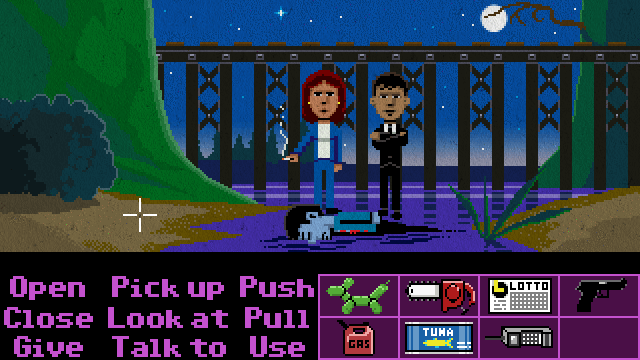
 Ron Gilbert and Gary Winnick
Ron Gilbert and Gary Winnick
If you ever happened upon the classic adventure game Maniac Mansion, that’s exactly what you’ll think of when you look at Thimbleweed Park. The giant pixels! The big heads! The list of clickable verbs!
That’s no coincidence, and it’s no mere homage, either: Thimbleweed, currently seeking funding on Kickstarter, is created by the same crew that designed LucasArts’ genre-defining masterpiece back in 1987. Those nostalgic graphics are opening fans’ wallets: Thimbleweed met its Kickstarter goal of $375,000 in less than a week, and is just over half a million dollars in funding today.
But the designers behind the game point out that the retro style isn’t just for scoring cool points. The big pixels are an integral part of making the game they want to make.
“Using simpler or retro graphics allows smaller teams to make interesting and innovative games,” says designer Ron Gilbert. “It’s one of the reasons we see such a huge surge in the indie scene right now.”
It was at George Lucas’ Skywalker Ranch in the 1980s that Gilbert and co-designer Gary Winnick created the cult classic Maniac Mansion, an adventure game that helped establish the “point-and-click” genre. Instead of having to type commands into a text parser like Sierra’s King’s Quest, you could see all the possible actions and click on words and pictures to string together a text command.
Later adventure games ditched the text for graphical icons, and significantly reduced most of those verbs down to one: “Use.” Thimbleweed Park, which the team hopes to release in June 2016, brings back the text.
The pitch is a little bit Twin Peaks, a little bit True Detective: In the town of Thimbleweed Park (population: 81), a dead body mysteriously turns up bobbing down the town river, prompting two has-been detectives to head to the scene. From there, the player bounces between five quirky playable characters, also including a cursed clown who can never take off his makeup and a woman sitting through the reading of her rich dead uncle’s will.

 Ron Gilbert and Gary Winnick
Ron Gilbert and Gary Winnick
“The art style we chose helps in keeping the cost down,” says Gilbert. Compared to other games funded through Kickstarter, Thimbleweed isn’t asking for much. Even its stretch goals only go up to $625,000. Broken Age, by Gilbert’s fellow LucasArts alum Tim Schafer, ended its crowdfunding run at $3.3 million in 2012.
But it’s about more than just cost. Simpler graphic presentations can attract more players, said Winnick.
“People immediately understand what you’re putting in front of them,” says Winnick. “It’s kind of like playing as the Scotty dog in Monopoly. It’s very identifiable and accessible.”
But the reason they’re using this style might even be more fundamental than all that. Do you think the best adventure games ever made featured classic 2-D graphics? Gilbert says the reason for that might be more than pure nostalgia.
“Iteration is really important in adventure game [design],” he said. “To quickly get things into the game and see how they feel. Being able to move fast is good because when you throw something out, you’re not wasting twenty artists’ time who are all building 3-D models.”
Keeping the team small, Gilbert says, is also important to creativity. Gilbert and Winnick never had any real disagreements during Mansion’s development. That’s really saying something, considering they didn’t just share an office back in the day—they shared a condo, too.
“You’re not dealing with a whole bunch of people you need to manage,” Gilbert says. “I’ve managed teams of 20 or 30 people, spending more time managing than designing or programming.”
And if you’re making a game that really depends on wacky scenarios and offbeat humor, as LucasArts’ classic adventures often did, a game made by a handful of people who get each other’s jokes has got to be better than one designed by a massive humor committee.
“Indies have the freedom to fail and that’s very important for creativity,” says Gilbert. “When you’re spending $30 million to make a game, you don’t try new things.”
